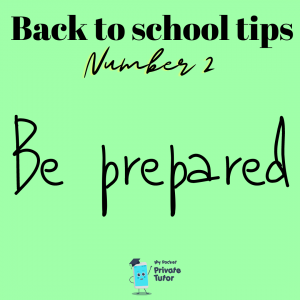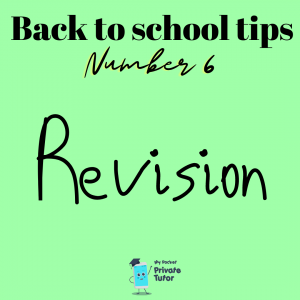Is your child starting Year 6 this September?
Read on for some tips to help ease the transition now that the whirlwind couple of years of lockdowns, bubbles and home learning has eased.

Settling back into school after the six week holidays is never an easy adjustment, let alone after the chaos and unpredictability of partial school closures and bubbles being sent home over the last few years. The Year 6’s this year have experienced a particularly unusual time, having missed out on a large chunk of school time in Year 3 and then entering a completely unfamiliar learning environment in Year 4 with rows, no joint assemblies, bubbles and living in constant fear of being sent home to isolate because of somebody they had crossed paths with momentarily. Then last year, things started to have glimpses of “normal” albeit with moments of increasing covid cases still impacting attendance of both children and their teaching staff. We have all learned to expect the unexpected, but as the Year 6 SATs took place in May 2022 for the first time since 2019, it is pretty certain they will be taking place again in May 2023.
Anxious, excited, under pressure, uncertain and that’s just us parents, right? Here are my top tips to ease the transition back to school.
Sleep and get up times
The first thing that affects us all (adults or children) when we come out of a routine is our sleeping habits. With the best intention in the world, our bedtime and wake up time often changes and can be the biggest thing that affects kids when they’re back in class.

It won’t be surprising to hear that being tired affects your ability to learn and engage, so the first thing is to work on getting the sleep routines back to where they need to be to enable your child to have good energy levels during their school day. It’s a great idea to start the school sleep routine the week before you go back to school so there is time to adjust. They may be 10 years old but pre-bedtime routines are still very helpful, things like having a half-hour wind down time before bed. Putting electronic devices down is a must to allow their minds to relax. Reading a book or listening to some calming music are things I have found to be helpful.
Be prepared
Is there anything new you need in Year 6? Does your school have specific uniform, or a book list or recommended stationery? Have you checked your child’s shoe sizes. We all know about crazy summer growth spurts. Get ahead of the game and don’t leave things until the last minute.

It’s really important to start developing your children’s independence at this age so let them be involved in getting their things ready for the next day before they go to bed. Do they have their uniform ready? Do they need to bring particular equipment to school now? Has there been a change of school opening time or route in or out of the school? If they think about these things the night before they will wake up knowing that they are prepared and it will create a far calmer atmosphere.
Vent
Discuss any of their anxieties and concerns but don’t put your anxieties on to them, ask how they feel. Be calm and positive. If you worry they will worry more.

Ask your children how they’re feeling but be careful not to ask leading questions: How are you feeling? not Are you feeling worried?. You may be anxious, OR you could also be very excited for your child to go back to school. Either way, your child might have completely different feelings to you and they can often surprise us with what is actually on their mind! So ask the question, ask them how they’re feeling, let them discuss it and respond calmly. When we worry, they worry. If we can react calmly to their concerns and answer questions honestly, it is reassuring for them.
Learning for life
Make learning an everyday thing, not just a school thing. Read, do puzzles, encourage them to learn facts about whatever they enjoy or are interested in. It keeps the brain engaged.

Children that have learning opportunities as part of their everyday life find it far easier to transition back into school. If you label learning as a “school thing” then it will be a big adjustment having to go back in and do 5 or 6 lessons on the trot. They will always view learning as a chore rather than the special privilege that it is. Whether you are in school or not, making reading a daily habit, engaging with puzzles or simply learning and talking about a topic of their own choice will ensure that their brains are always engaged and that they value their right to an education.
Happy and healthy
Wellbeing is paramount but that doesn’t mean glossing over the hard work and focus you need in Year 6. Be honest from the get go. Its an important but rewarding year.

If your child is distressed in anyway, if they’re not sleeping or eating well, if there are emotional issues on their mind, these things will all be barriers to learning. Tackling these things are the number one priority. We need happy, healthy, safe children before they can even begin to learn.
It’s important though, not to mistake well-being for being over protective.
It’s a fine line. There is some pressure involved in preparing for tests but not all pressure is bad. Learning to be accountable is good preparation for life. Year 6 IS a big year. It’s an important year. It’s a year that many primary school children look forward to because they get to take on special school roles, they get to be the top of the school and it’s the last year that they are potentially together with children they may have spent the last six or seven years of their life with before they move on to secondary school and start again as the little ones.
The S word
The end of Year 6 is marked by the SATs tests. If you’ve had children in Year Six before you will know that the SATs (rightly or wrongly) are often the focus of the year. Despite the fact that the children have missed a lot of school during Key Stage Two, the SATs tests are still scheduled to go ahead in May. Regardless, the knowledge still needs to be learned to provide a solid foundation for more complex material in secondary school.

Children will all be at varying levels dependent on their unique experiences of school closure and teachers will have to work extra hard to identify gaps and to provide differentiation for children who will be at even more varying levels now than ever before. In reality, limited resources in schools means that support will usually go where its deemed to be needed the most. If you want your child to truly meet their potential, you will need to take that extra bit of responsibility towards putting in any extra work that’s needed. If you are unsure if your child has left Year Five with gaps, the Year 5 diagnostic tool has been designed to help you identify just that. Using the tool will help you find any specific areas that your child should focus on so that they can catch up with what they need to know and make good progress in Year Six.
Where do I find good revision material for the Year 6 Maths SATs?

If you would like support specifically with the Maths SATs papers check out my Year 6 SATs revision app. I have put this together to offer video tutorials, worksheets and practice SATs test questions for every single Year 6 Maths learning objective that is part of the National Curriculum. It is completely free to download and you can try out 6 lessons before deciding if its for you or not!
You can also come join my Year 6 SATs Facebook group to get access to free resources, ideas and tips to help pass the tests in May.





Leave a comment
Sign in to post your comment or sign-up if you don't have any account.